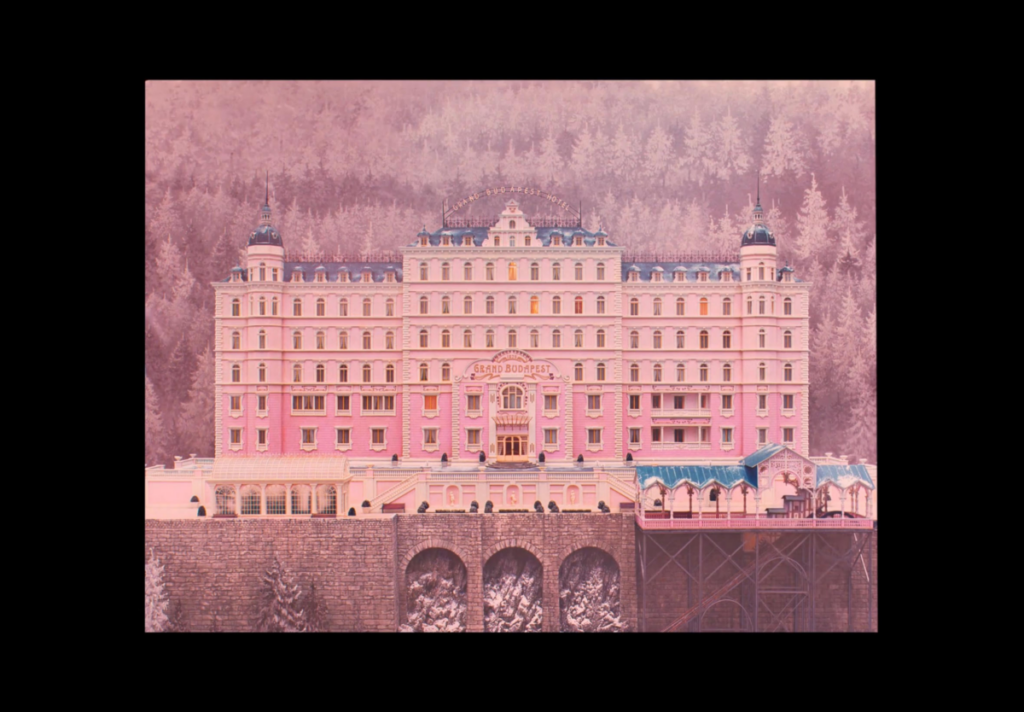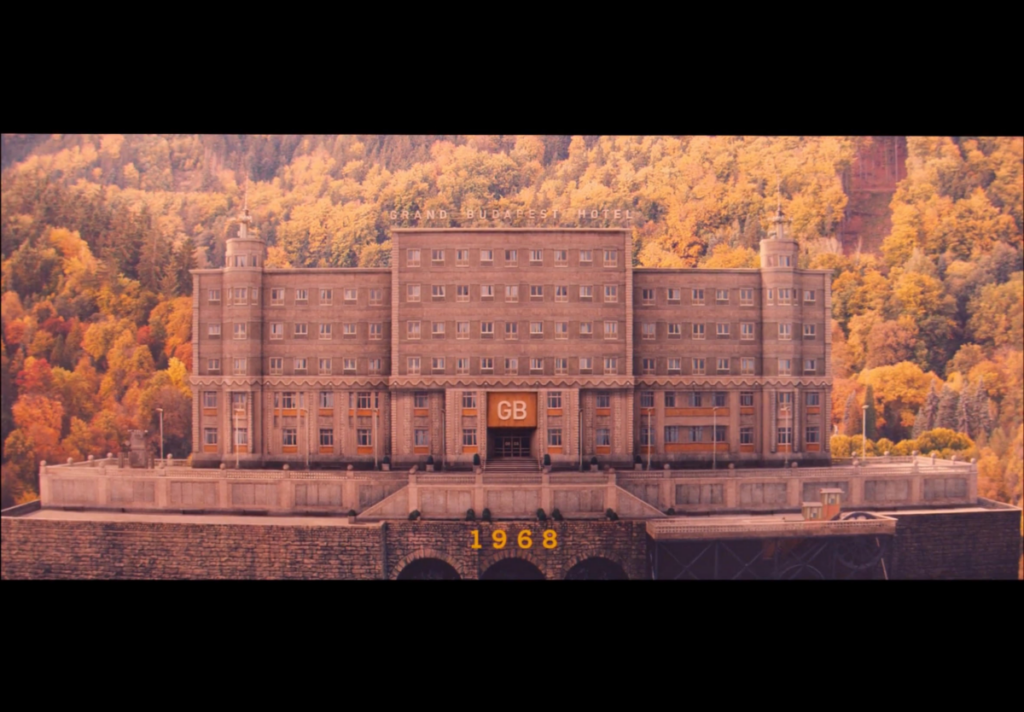“The Grand Budapest Hotel” is a comedy/adventure film directed by Wes Anderson. Though I have previously watched and largely enjoyed “Fantastic Mr. Fox,” one of Anderson’s prominent movies, I was mostly unfamiliar with his work.
The film creatively initiates with the concluding scene, which leaves thought for the audience to understand this scene by the time the story ends. The first introduction to the actual Grand Budapest Hotel felt like an incredibly refreshing scene; the beautiful scenery and colorful palette of the hotel and its surroundings demonstrate the aesthetics of this setting. This immediately demonstrates Anderson’s effective use of mise-en-scène throughout the film to transfer certain emotions to the audience. However, as film transitions into the hotel’s appearance in 1968, it remains with a gorgeous background, but lacks the colorful and visual aesthetic previously shown. This change in scenery created an ominous feeling of some underlying problems.
Figure 1: The Grand Budapest Hotel in the 1930s

Figure 2: The Grand Budapest Hotel in the 1960s

As the film progressed, many creative and influential cinematic decisions became evident. For instance, each time-shift in the film led to a different aspect ratio of the portrayal of the movie. I first noticed this change from the aforementioned transition into the hotel in 1968, which increased the aspect ratio to a more “modern” style (see Figure 1 and Figure 2). These changes allow the audience to feel the time shifts naturally within the film. Moreover, Anderson inserts three different narrative layers depending on the section of the film. In general, the movie is divided into three subsections of different time periods: present time, the 1980s, and the 1930s. The narrator of the present time is revealed at the very start of the film: the lady at the cemetery reading the “Grand Budapest Hotel” book written by the unnamed “Author,” which is then revealed as a younger self, stationed at the hotel. The unnamed author then proceeds to become the narrator of the “1980s” subsection, in which he visits the hotel and converses with Zero Moustafa, the final and main narrator of the film, corresponding to the “1930s” subsection. The creative decision of narrator switches allowed for a smooth transition between eras of the hotel, connecting all three characters through the film. Finally, another highlight from the film was its prevalent use of color and suiting music throughout every scene. From start to finish, the Grand Budapest Hotel felt like a total fever dream; the color coordination and symmetry created beautiful visuals. The symmetrical balance of the hotel and these vibrant color palettes portrayed the hotel almost like a doll-house of sorts. The film included atmospheric sounds, fitting for every scene.
In terms of the character interactions throughout the movie, I heavily enjoyed Zero’s narrative of the story, specifically the dynamics between him and Gustave. From start to end, the audience is able to see their genuine emotional connection, representing a mix of loyalty, friendship, and Gustave’s father figure to Zero. As we learn their story through Zero’s point of view, the theme of nostalgia is apparent. After learning the adventures of this duo, it adds a meaningful perspective to Zero’s legacy as the owner of the Grand Budapest Hotel.
One aspect of mise-en-scène in the Grand Budapest Hotel that was very prominent to me was the lighting. The lighting shifts from darker with more shadows to high-key depending on the scene’s mood. For instance, many of Willem Dafoe’s scenes are shot with a darker tone as he is one of the main antagonists. Wes Anderson uses lighting to tell the audience about a character, like the close-up shot of Agatha with soft red lighting surrounding her face giving the impression of a warm and good-natured character. This shot also further demonstrates Zero’s infatuation with her. I agree that the color palettes created a sort of fever dream-like scene and after doing some more research on the film, I found out that Wes Anderson opted to use miniatures for many of the larger shots of buildings (like the one of the hotel). I wonder why he chose to do this and if this made it feel strange and “fever-dream-like” or if it was more within his camera movements and unique symmetrical shots.
Something I think many viewers pick up on is the non-linear story telling aspect of the film. I like how you bring up how the film begins with the ending scene. From that shot until the last one Anderson designs his shots so that viewers can always tell which time period we are seeing. The shifts from pink to yellow to cold blue in the color palette represent the emotional attachment Zero has to the hotel in each of the respective time periods. Ultimately this story is limited to one specific character’s perspective on its events, so it makes sense why Grand Budapest Hotel is seen as an example of how careful storyboarding and mise en scene can build the relationship between characters and the viewer. The part of the film that really echoed this sentiment was the shot where Gustave and the prisoners snuck through the guards’ barracks. The combination of various shots with different figure movements reinforces the idea that Zero did not in fact witness many events of the film first-hand, but is still able to reflect with nostalgia on those events (much like the camera as the viewer).